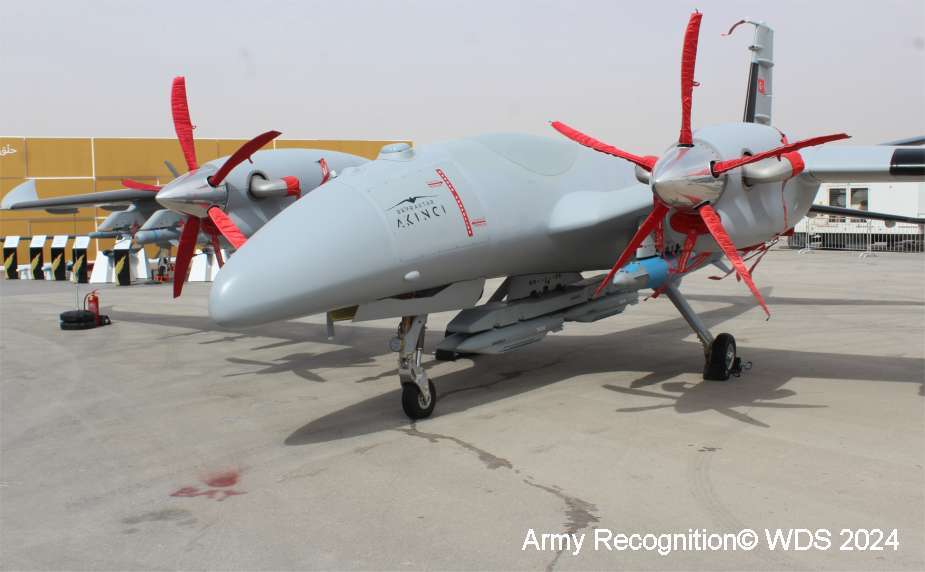Breaking news
Azerbaijan enhances air defense capabilities with Turkish Bayraktar Akıncı drone.
Azerbaijan showcased its latest addition to its military arsenal, the Bayraktar Akıncı drone, during a notable visit by President Ilham Aliyev to the Azerbaijani Air Forces' academy on February 9th, 2024. This unveiling underscores Baku's ongoing commitment to enhancing its defense capabilities using advanced technologies.
Follow Army Recognition on Google News at this link

Turkish Baykar Bayraktar Akıncı drone selected by Azerbaijani forces (Picture source: Army Recognition)
According to the Ministry of Defence, President Aliyev was briefed on the facilities established at the academy for personnel training and witnessed a demonstration flight of the Akıncı, marking the successful integration of this cutting-edge technology into the Azerbaijani arsenal. Photographs released by the presidential office displayed an Akıncı with Azerbaijani markings and serial number S46, indicating recent production and highlighting the rapid expansion of the country’s drone fleet.
This acquisition positions Azerbaijan among the first international users of the Bayraktar Akıncı, joining other air forces such as Pakistan, Ethiopia, and Kyrgyzstan. The visit also featured an inspection of a range of air-launched weapons, including Roketsan's SOM cruise missile, the MAM-T laser-guided bomb, and a general-purpose bomb equipped with a glide kit.
Baykar, the Turkish manufacturer of the drone, plans to integrate the SOM-A cruise missile into the drone, providing the Akıncı with a long-range strike capability of 250 km. Although specific progress on this integration was not detailed, successful tests with the shorter-range Çakır cruise missile, as well as with the MAM-T and an Mk 82 bomb fitted with a guided glide bomb kit, have been confirmed.
Azerbaijan's investment in the Akıncı drone reflects the evolution of its defense strategy, prioritizing modernization and technological efficiency. During the Second Nagorno-Karabakh War in 2020, the effective use of drones demonstrated their strategic value, prompting Baku to further develop this key component of its military force.
Azerbaijan's commitment to enhancing its defense and surveillance capabilities through advanced combat drones like the Akıncı, in collaboration with strategic partners such as Türkiye, highlights the growing dynamics of regional military cooperation. This cooperation extends beyond UAV acquisitions to include ambitious projects like the joint development of fifth-generation fighter aircraft, marking a new era in defense relations between Azerbaijan and Türkiye.
Equipped with dual artificial intelligence avionics, the Akıncı supports real-time signal processing, sensor fusion, and situational awareness. It features advanced systems including electronic support systems, dual satellite communication systems, air-to-air radar, collision avoidance radar, and synthetic aperture radar.
Designed to perform operations typically carried out by fighter jets, it serves as a versatile asset for both air-to-ground and air-to-air attack missions. Its triple redundant electronics and software systems enable it to carry a wide range of payloads, including smart munitions, guided bombs, missiles, and deterrence weapons. Additionally, it will be equipped with a multifunctional AESA radar system for air-to-air combat and synthetic weather estimation.
In terms of flight performance, the Akıncı boasts impressive capabilities, including a maximum flight altitude of 40,000 feet and up to 24 hours of flight time. It features fully automatic flight control, automatic takeoff and landing capabilities without dependence on ground systems, as well as precise auto takeoff and landing with integrated sensor fusion. With a payload capacity of 1,500 kg, it can simultaneously carry a diverse range of ISR payloads and munitions.
The Bayraktar Akıncı is operated from a ground control station equipped with radio systems, pilot consoles, payload operator consoles, and image exploitation consoles. It utilizes triple bands for line-of-sight (LOS) control and video transmission, with beyond-line-of-sight (BLOS) operations supported via satellite communication (SATCOM). BLOS operations can be conducted over existing worldwide satellite networks, and SATCOM data terminals can be provided as needed.























